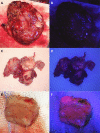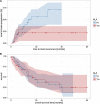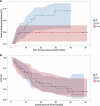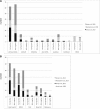5-ALA fluorescence of cerebral metastases and its impact for the local-in-brain progression
- PMID: 27564260
- PMCID: PMC5341837
- DOI: 10.18632/oncotarget.11488
5-ALA fluorescence of cerebral metastases and its impact for the local-in-brain progression
Abstract
Aim of the present study was to analyze the oncological impact of 5-ALA fluorescence of cerebral metastases. A retrospective analysis was performed for 84 patients who underwent 5-ALA fluorescence-guided surgery of a cerebral metastasis. Dichotomized fluorescence behavior was correlated to the histopathological subtype and primary site of the metastases, the degree of surgical resection on an early postoperative MRI within 72 hours after surgery, the local in-brain-progression rate and the overall survival. 34/84 metastases (40.5%) showed either strong or faint and 50 metastases (59.5%) no 5-ALA derived fluorescence. Neither the primary site of the cerebral metastases nor their subtype correlated with fluorescence behavior. The dichotomized 5-ALA fluorescence (yes vs. no) had no statistical influence on the degree of surgical resection. Local in-brain progression within or at the border of the resection cavity was observed in 26 patients (30.9%). A significant correlation between 5-ALA fluorescence and local in-brain-progression rate was observed and patients with 5-ALA-negative metastases had a significant higher risk of local recurrence compared to patients with 5-ALA positive metastases. After exclusion of the 20 patients without any form of adjuvant radiation therapy, there was a trend towards a relation of the 5-ALA behavior on the local recurrence rate and the time to local recurrence, although results did not reach significance anymore. Absence of 5-ALA-induced fluorescence may be a risk factor for local in-brain-progression but did not influence the mean overall survival. Therefore, the dichotomized 5-ALA fluorescence pattern might be an indicator for a more aggressive tumor.
Keywords: 5-aminolevulinic acid; cerebral metastases; in-brain-progression; overall survival; recurrence.
Conflict of interest statement
Prof. Sabel is a consultant for Johnson & Johnson Company and Integra Company. All other authors certify that they have no affiliations with or involvement in any organization or entity with any financial interest (such as honoraria; educational grants; participation in speakers’ bureaus; membership, employment, consultancies, stock ownership, or other equity interest; and expert testimony or patent-licensing arrangements), or non-financial interest (such as personal or professional relationships, affiliations, knowledge or beliefs) in the subject matter or materials discussed in this manuscript.
Figures





Similar articles
-
Is 5-ALA fluorescence of cerebral metastases a prognostic factor for local recurrence and overall survival?J Neurooncol. 2019 Feb;141(3):547-553. doi: 10.1007/s11060-018-03066-y. Epub 2018 Dec 10. J Neurooncol. 2019. PMID: 30535595
-
Intraoperative 5-aminolevulinic acid-induced photodynamic diagnosis of metastatic brain tumors with histopathological analysis.World J Surg Oncol. 2017 Sep 29;15(1):179. doi: 10.1186/s12957-017-1239-8. World J Surg Oncol. 2017. PMID: 28962578 Free PMC article.
-
Impact of the combination of 5-aminolevulinic acid-induced fluorescence with intraoperative magnetic resonance imaging-guided surgery for glioma.World Neurosurg. 2011 Jul-Aug;76(1-2):120-7. doi: 10.1016/j.wneu.2011.02.005. World Neurosurg. 2011. PMID: 21839963
-
5-ALA fluorescence-assisted surgery in pediatric brain tumors: report of three cases and review of the literature.Br J Neurosurg. 2014 Dec;28(6):750-4. doi: 10.3109/02688697.2014.913779. Epub 2014 May 5. Br J Neurosurg. 2014. PMID: 24799277 Review.
-
Aminolevulinic acid (ALA)-protoporphyrin IX fluorescence guided tumour resection. Part 1: Clinical, radiological and pathological studies.J Clin Neurosci. 2012 Nov;19(11):1471-4. doi: 10.1016/j.jocn.2012.03.009. Epub 2012 Sep 5. J Clin Neurosci. 2012. PMID: 22959448 Review.
Cited by
-
Quantification of ALA-fluorescence induced by a modified commercially available head lamp and a surgical microscope.Neurosurg Rev. 2018 Oct;41(4):1079-1083. doi: 10.1007/s10143-018-0997-2. Epub 2018 Jul 23. Neurosurg Rev. 2018. PMID: 30039396 No abstract available.
-
5-Aminolevulinic Acid Fluorescence Indicates Perilesional Brain Infiltration in Brain Metastases.World Neurosurg X. 2019 Dec 16;5:100069. doi: 10.1016/j.wnsx.2019.100069. eCollection 2020 Jan. World Neurosurg X. 2019. PMID: 32095783 Free PMC article.
-
Photodynamic Detection of Peritoneal Metastases Using 5-Aminolevulinic Acid (ALA).Cancers (Basel). 2017 Mar 1;9(3):23. doi: 10.3390/cancers9030023. Cancers (Basel). 2017. PMID: 28257041 Free PMC article. Review.
-
Quantification of PpIX-fluorescence of cerebral metastases: a pilot study.Clin Exp Metastasis. 2019 Oct;36(5):467-475. doi: 10.1007/s10585-019-09986-x. Epub 2019 Aug 2. Clin Exp Metastasis. 2019. PMID: 31376098
-
Applications of Focused Ultrasound in Cerebrovascular Diseases and Brain Tumors.Neurotherapeutics. 2019 Jan;16(1):67-87. doi: 10.1007/s13311-018-00683-3. Neurotherapeutics. 2019. PMID: 30406382 Free PMC article. Review.
References
-
- DeAngelis LM. Brain tumors. The New England journal of medicine. 2001;344:114–123. - PubMed
-
- Tsao MN, Rades D, Wirth A, Lo SS, Danielson BL, Vichare A, Hahn C, Chang EL. International practice survey on the management of brain metastases: Third International Consensus Workshop on Palliative Radiotherapy and Symptom Control. Clin Oncol (R Coll Radiol) 2012;24:e81–92. - PubMed
-
- Soffietti R, Ducati A, Ruda R. Brain metastases. Handb Clin Neurol. 2012;105:747–755. - PubMed
-
- Soffietti R, Trevisan E, Ruda R. Targeted therapy in brain metastasis. Curr Opin Oncol. 2012;24:679–686. - PubMed
-
- Goeckenjan G, Sitter H, Thomas M, Branscheid D, Flentje M, Griesinger F, Niederle N, Stuschke M, Blum T, Deppermann KM, Ficker JH, Freitag L, Lubbe AS, et al. Prevention, diagnosis, therapy, and follow-up of lung cancer: interdisciplinary guideline of the German Respiratory Society and the German Cancer Society. Pneumologie. 2011;65:39–59. - PubMed
MeSH terms
Substances
LinkOut - more resources
Full Text Sources
Other Literature Sources
Medical

